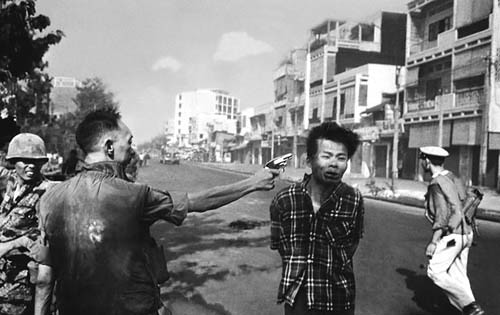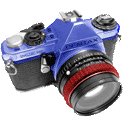|
Foreword to the Foreword This thread is for Sony DSLR and SLT bodies. In the off-chance anyone wants to talk about their Minolta autofocus SLR or Konica-Minolta DSLR, feel free. If you’re looking for NEX info, you’re probably better off in the mirrorless thread. If you’re looking for info on the RX100, check out the point-and-shoot thread. If you own a RX1, you’re made of money and are free to buy your own forum. Foreword About five years ago, when I first got into photography, I asked a wedding photographer for some advice on where to begin. She told me to get a DSLR made by Canon or Nikon. I looked down at the a700 in my hands and wondered, “What can’t I do with what I already have?” Consider, for a moment, two of the most famous photos shot in the past fifty years.  Street execution of a Viet Cong prisoner, Saigon, 1968 by Eddie Adams  Afghan Girl by Steve McCurry The first is a perfect example of being the right place at the right time with a functional camera. The other is a well-composed, well-exposed portrait of an interesting subject, shot by a photographer who understands how to make use of such things. What does the brand of the cameras involved have to do with the greatness of these shots? Nothing. Nothing at all. History To understand Sony’s DSLR line, you need to know a bit about Minolta. Minolta was one of the major players in the SLR market for a very, very long time. They never had the market penetration of Canon or Nikon, but they had a reputation for good image quality and ease of use. They were the first to market with an autofocus SLR line. They color-matched their lenses against each other so that photographers could feel confident that their shots would look consistent if they switched lenses halfway through a roll of film. They came out with their first DSLR in 1995. Their Dimage enthusiast point-and-shoot line included manual controls, image stabilization, and a flip-out rear LCD in 2003. Unfortunately, a major lawsuit from Honeywell and declining marketshare took the wind (money) out of Minolta’s sails, which led to their acquisition by Konica. The brand struggled on under the name Konica-Minolta and was eventually sold to Sony. You can say a lot of things about Sony, and most of them are true. But at the end of the day, they’re a business and they do a lot of research into what “the market” wants. Their early DSLRs fell into two categories:
What is SLT? Single Lens Translucent, which is a hybrid of Single Lens Reflex and mirrorless technology. As a quick refresher, here’s how SLRs and mirrorless cameras work:  Let’s start with the DSLR. When you look through the viewfinder, you see light that travelled through the lens, bounced off a mirror, reflected up into another mirror (or a prism), and out the eyepiece to you. When you press the trigger, the first mirror pivots upward. This allows the light to hit the sensor, capturing the photo itself. Once the capture is complete, the pivoting mirror rotates back down. It’s a proven technology, but not a perfect one. Nice pentaprism viewfinders are bulky and expensive, whereas cheap penatmirrors tend to be small, dim things that cut off the edges of your shot. During exposure, your autofocus sensors have nothing to focus on, so you can lose track of moving subjects. Without that autofocus sensor, video on a DSLR can be tricky. Finally, think about the mechanical precision needed to make a tiny mirror slap back and forth instantly, several times a second, while staying in sync with other tiny moving parts. Then think about the quality of most consumer electronics. How fast can they really move? And how long will they really last? The mirrorless camera is much simpler mechanically – no pivoting mirror, no optical viewfinder. The sensor provides a constant live-view mode to the rear LCD or an electronic viewfinder. This allows for a smaller, lighter camera with fewer moving parts. With no mirror, you eliminate the potential of mirror-shake ruining long-exposure shots (as well as eliminating the need for a mirror lock-up mode). Unfortunately, you also lose out on the faster, more accurate autofocus sensors built into DSLRs. You’re also limited by the quality of your output display – it’s hard to compose a shot, or judge image quality, if you’re stuck with a crummy screen to view it on. SLT is Sony’s way of blending both technologies.  There’s still a mirror involved, but it’s not a normal mirror. It constantly reflects about 1/3rd of the light onto an autofocus sensor, while the other 2/3rds of the light travels through the mirror to the sensor. The sensor then powers an electronic viewfinder. This lets Sony pull off some neat tricks:
General Perks of the Alpha Mount You don’t have to buy a SLT in order to get the most out of a Sony.
Before I recommend any specific bodies, let me explain the numbering system. When looking at a Sony DSLR/SLT (or even a NEX, though they’re beyond the scope of this thread), look at the first digit. It will tell you how Sony views the camera in terms of other DSLRs from the same generation of technology. Then, count the total number of digits. If it has three digits (like a700), it’s a DSLR. If it has two digits (like a77), it’s a SLT.
Now, if you’re made of money, we can talk about full-frame options. Sony has three full-frame bodies – the a850, the a900, and the a99. The a900 is basically an a700 with a gigantic viewfinder, a larger sensor, and (I believe) an even sturdier build. Though they aren’t officially weather sealed, Antarctica is no big deal to an a900. So, if you found yourself smiling and nodding as I described the a700, and you have the cash for it, go for it – you can find them on eBay for $1500ish. If that’s a bit too rich for your blood, get an a850 – it’s an a900 with an oh-so-slightly smaller viewfinder and only shoots 3 frames per second, and goes for $1000-$1100. If you’re looking for a portrait or landscape full-frame camera, it’s one of the best deals on the market. Then, there’s the a99. Oh my god, the a99. The a99 is the nicest camera I’ve ever used. Sony managed to include everything I’ve liked from previous bodies. The a700/a850/a900 had a very simple interface; the a99 has it. The a850 and a900 have a full-frame sensor; the a99 has one. The a580 had excellent low-light capabilities, where ISO 3200 was not just usable, but no big deal; the a99 laughs at ISO 3200. I can’t think of a single meaningful problem with the a99, except perhaps the fact that the autofocus points could be spread out a little more. It’s an excellent camera, and I have no hesitation in recommending it to anyone – provided, of course, you have the money and the know-how to use it. What are some bad Sony bodies? First off, I’ll say what I said in the My First DSLR thread – no one makes a “bad” DSLR anymore. Not Canon, not Nikon, not Pentax, and not Sony. None of the Sony bodies will blow up if you try to use them. All of them are usable up to at least ISO 1600, and will work for 90% of the situations the average person would use them in. With that out of the way, the a230 is the red-headed stepchild of the Sony lineup. As an entry-level body, it has a lot of features stripped out of it. It has the smallest viewfinder of any Sony DSLR. It’s also several years old at this point. If you’re going to go the used route, I’d encourage you to keep searching – you should be able to find a comparable body (a200, a300, a330) for essentially the same price. In addition, I have trouble recommending the a65. As mentioned above, the a65 is basically an a77’s guts in an entry-level body. Sounds good, right? One of the few problems with the a77 is its sensor. 24 megapixels on a crop-sensor is very dense, and it’s hard to find lenses that can really take advantage of that high resolution. It’s not that your photos will be bad, it’s that they won’t be able to take advantage of the sensor’s full potential – you’ll only really have 18 or 20 megapixels (or whatever) worth of detail. So, unless you have really nice lenses, you’re basically spending extra money for a sensor you can’t take full advantage of, plus a nicer viewfinder. I think you’re better off with an a57 (16 megapixels versus 24) or an a77 (a65 with a sturdier build, better rear LCD, and dual-control wheels). Any Sony/Minolta terminology I should know about? A few quick ones:
Note the use of "unique". Obviously, lenses like the Tamron 17-50mm f/2.8 are good, and adapted m42 lenses are a dime a dozen. However, if you've read the My First DSLR or general gear threads, you already know about them. Here are some goodies that are just for you, you beautiful and unique little snowflake.
When I describe a lens as "rebadged", I'm mostly referring to cosmetic changes to the barrel itself. The optical formula is the same - x elements in y groups. There may be some changes to the coatings, particularly if the original design is a Tamron. If there are any other significant changes, I'll make note of it below - otherwise, assume the lenses are essentially identical. You can save a boatload by buying the older versions of these lenses.
Ask questions, discuss gear. Argue about who has the best Beercan (it's me, I have the best Beercan because it's a crossed-x). Bob Socko fucked around with this message at 23:00 on Jul 20, 2013 |
|
|
|

|
| # ? Apr 19, 2024 00:57 |
|
The best mount now has the best OP. :amugdog: You might want to mention that the 35 1.8 is a DT lens, though. That is why the Minolta 35 f/2 is sought after
|
|
|
|
Good catch, thank you.
|
|
|
|
Wish I could have read this couple weeks ago before I bought the A65. Oh well, so far I am really enjoying it. It's my first DSLR so I will be creeping around these forums for tips and advice. Thanks for the awesome first post. So much useful information.
|
|
|
|
Great OP! Pete Ganzel's site is indeed excellent. I had to clean up the blades on my 50/1.7 RS a while ago and thanks to his detailed instructions it was a breeze.
|
|
|
|
The Sony Alpha Rumors link doesn't work. Besides that can anyone recommend a macro lens for an a57? I'm just starting to look into the different things you can do with them so I have no idea what's good or what length is right for me. I would mainly be taking pictures from only a couple feet away so a 50mm would probably do I'm assuming.
|
|
|
|
Lando2 posted:The Sony Alpha Rumors link doesn't work. Knowing what your subjects are/will be* is crucial if you want a better recommendation than the usual "just buy a Tamron 90/2.8" *Warhammer figures? Flowers? Critters?
|
|
|
|
Lando2 posted:The Sony Alpha Rumors link doesn't work. As for your question, I see the distance involved, but what exactly will you be shooting? If you're shooting insects, you'll really appreciate the extra reach of a 90/100mm macro. Otherwise, a 50mm macro should work great.
|
|
|
|
Yeah pretty much random poo poo in my house. Nothing too naturey.
|
|
|
|
A last-minute shoot tomorrow means that I picked up the Carl Zeiss 16-35 from borrowlenses. This thing is a tank. Also, Bob, I'd still like that 17-35, I finally just got paid. I should PM you about it. 
|
|
|
|
Lando2 posted:Yeah pretty much random poo poo in my house. Nothing too naturey. kefkafloyd posted:Also, Bob, I'd still like that 17-35, I finally just got paid. I should PM you about it.
|
|
|
|
I literally did not get payment until Monday. Truthfully though I need a 28-70 type lens first.
|
|
|
|
Presumably this is something that went through proper channels in the buy/sell thread.
|
|
|
|
No, but there was also no definite agreement nor money exchanged.
|
|
|
|
Unrelated bump - is there any interest in me posting a list of what alpha mount lenses are rebadged versions of other lenses? If so, should it go in the OP or be kept separate to keep the OP from becoming too bloated?
|
|
|
|
Bob Socko posted:Unrelated bump - is there any interest in me posting a list of what alpha mount lenses are rebadged versions of other lenses? If so, should it go in the OP or be kept separate to keep the OP from becoming too bloated? If it's too big for the OP I can just edit kefka's first post, if that's ok with kefka of course.
|
|
|
|
Soundmonkey editing my posts? Why I never! (Actually I am ok with this)
|
|
|
|
There should be enough room, I was thinking more along the lines of bloat. It's not too long as it is, so I'll put it in the OP once complete. Stay tuned.
|
|
|
|
Bob Socko posted:There’s still a mirror involved, but it’s not a normal mirror. It constantly reflects about 1/3rd of the light onto an autofocus sensor, while the other 2/3rds of the light travels through the mirror to the sensor. canon did it first 
|
|
|
|
You're right. And, like Canon, Sony views translucent mirrors as a stopgap technology. The next generation of a-mount cameras will probably do away with the mirror altogether. Hopefully, they make less of a mess of it than Pentax did. In other news, I've updated the OP with the rebadging section. It's towards the bottom, after the lens recommendations. I think I've caught all the rebadged lenses, but if I'm missing one, please let me know.
|
|
|
|
Bob Socko posted:You're right. And, like Canon, Sony views translucent mirrors as a stopgap technology. The next generation of a-mount cameras will probably do away with the mirror altogether. Hopefully, they make less of a mess of it than Pentax did. Hey don't slander the k-01.
|
|
|
|
The k-01 does have a really nice sensor in it. I think it would have been more successful if it looked less cartoonish and/or had nicer ergonomics.
|
|
|
|
Bob Socko posted:The k-01 does have a really nice sensor in it. I think it would have been more successful if it looked less cartoonish and/or had nicer ergonomics. Also a shorter register distance and cheap passthrough adapter for K-mount lenses.
|
|
|
|
If anyone wants to buy a Beercan and feel rightfully superior, I have one for sale in the Buy/Sell thread now.
|
|
|
|
GWBBQ posted:If anyone wants to buy a Beercan and feel rightfully superior, I have one for sale in the Buy/Sell thread now.
|
|
|
|
$100 Beercan received. There's no original sales receipt, so I can't possibly make use of the included warranty card  Also there's no hood, but I took a few shots at the sun and it didn't seem to have any flaring problems. I've been meaning to get a Beercan ever since I got my Alpha 200 in 2008(ish?), so I'm pretty happy.
|
|
|
|
Just pick up some random rubber hood and you'll be in the clear. Then again, 55mm clip-on Minolta hoods are dime a dozen.
|
|
|
|
Opensourcepirate posted:Also there's no hood, but I took a few shots at the sun and it didn't seem to have any flaring problems. I've been meaning to get a Beercan ever since I got my Alpha 200 in 2008(ish?), so I'm pretty happy.
|
|
|
|
Anyone tried the second gen 18-55? I'm more of a prime guy but I needed a standard zoom and ended up buying the surprisingly good 18-55 a couple of years ago. Curious to see how the new one compares.
|
|
|
|
I'm selling a Sony 16-50mm f/2.8 SSM and a Tamron 90mm f/2.8 macro(1:1) over in the buy/sell thread if anyone is interested  . .
|
|
|
|
Tamron f/2.8 macro is glorious, highly recommended to anyone in the market.
|
|
|
|
DoctaFun posted:I'm selling a Sony 16-50mm f/2.8 SSM and a Tamron 90mm f/2.8 macro(1:1) over in the buy/sell thread if anyone is interested  THRILLED 2B HERE might be interested in your Tamron. THRILLED 2B HERE might be interested in your Tamron.
|
|
|
|
Bob Socko posted:Sorry about your fridge. Thanks Mr. Socko. I can replace the fridge easily enough, but money cannot replace the fresh venecin sticks that were lost 
|
|
|
|
If switching systems wouldn't cost a loving fortune every time, I'd probably be in for one of the next generation SLTs. Or whatever those with the autofocus on the sensor will be called. The focus peaking in the EVF is cool.
|
|
|
|
For those of you who have used the a77 or a58 (I can get a stupid good deal on the latter), what is it like for doing concert photography. Right now I'm using an old canon 5d to acceptable results, but I honestly love the feel of the sony's in my hands. So was curious what everyone's thoughts were.
|
|
|
|
|
Combat Pretzel posted:If switching systems wouldn't cost a loving fortune every time, I'd probably be in for one of the next generation SLTs. Or whatever those with the autofocus on the sensor will be called. The focus peaking in the EVF is cool. I think that you can put together a consumer level Sony system at an incredible steal. The built in image stabilization and somewhat lower demand but high quality Minolta lens can be a real steal. If you're a couple grand into an system, then yeah, the only thing you can do it sell that and try to replicate it with Sony.
|
|
|
|
Combat Pretzel posted:If switching systems wouldn't cost a loving fortune every time, I'd probably be in for one of the next generation SLTs. Or whatever those with the autofocus on the sensor will be called. The focus peaking in the EVF is cool. ManiacMatt posted:For those of you who have used the a77 or a58 (I can get a stupid good deal on the latter), what is it like for doing concert photography. Right now I'm using an old canon 5d to acceptable results, but I honestly love the feel of the sony's in my hands. So was curious what everyone's thoughts were. If you want better image quality at high ISO, get an a57 or a580 - they use the same sensor as the Nikon d7000 and Pentax K5, both of which are high-ISO monsters. If you're doing this professionally, get an a99 and don't look back 
Bob Socko fucked around with this message at 04:06 on Jun 13, 2013 |
|
|
|
Bob Socko posted:Out of curiosity, what's your setup like now? I'm not trying to be confrontational, I think it might be an interesting experiment to recreate someone's loadout if they were to switch teams.
|
|
|
|
Sony seems to be stepping up the consumer events this year, Vancouver has a meetup group hosted by the local Alpha rep now. May want to check your cities meetup page if you're canadian and interesting in that sort of thing. Complete list: Toronto Edmonton Vancouver Winnipeg These are all hosted by people in the Sony Digital Imaging Group. If you want to try new Sony equipment or just talk shop they are pretty great. Oh My Science fucked around with this message at 08:58 on Jun 12, 2013 |
|
|
|

|
| # ? Apr 19, 2024 00:57 |
|
What better way to explore/experiment with changing from CaNikon to Sony than to buy the lenses I need to sell! Seriously though I think Sony offers some great, cheap, 'entry level' lenses because of the Minolta compatibility, but there aren't really cheap replacements for a 35/1.4 or 24/1.4. It's probably easier to move from CaNikon to Sony based on the simple fact that it's a lot easier to unload CaNikon gear than it is Sony, as I'm finding out.
|
|
|
























